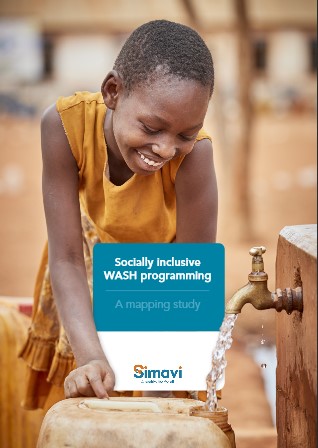Socially inclusive WASH programming.
 |
A mapping study of socially inclusive strategies and approaches in WASH programmes and projects of selected Dutch-based and international organizations active in the WASH sector.
rapport May 2018 ; 40 pages
Aut.
Ed. IRC - Den Haag
Téléchargeable sous format: PdF
Téléchargeable chez l'éditeur
Page de présentation d'un éditeur
Abstract:
This working paper is a mapping study of socially inclusive strategies and approaches in WASH programmes and projects of selected Dutch-based and international organisations active in the WASH sector. The paper first provides a conceptual framework for social inclusion and its connection to the human rights framework and the Sustainable Development Goals. The framework is translated into a set of critical questions to be addressed in each stage of the programme cycle and in relation to the Enabling Environment (EE). This is followed by a description of the different ways in which social exclusion and inequalities manifest itself in the WASH sector and the approaches employed in the WASH sector to prioritise people who are excluded from participation. The paper provides an overview of the socially inclusive WASH approaches, methods and activities shared by nine organisations: BRAC, GIZ, PLAN Nederland, SIDA, UNICEF, WaterAid, WaterWorx, World Bank and WSSCC. The presentation of the findings is organised according to the different stages of the programme cycle: the definition of strategies and intervention levels; the assessment and programming phase, the planning and design, implementation, monitoring and learning. The study found that the nine participating organisations are increasingly becoming aware of the need for addressing "social inclusion" as a precondition for overcoming existing inequalities and reaching universal access to sustainable services for all. There is a however a gap between what organisations have formulated in their strategies and programmatic approaches regarding social inclusion and the actual opportunities for implementation. Nevertheless, there is a wide range of approaches, methods and tools available that can overcome the gap between social inclusion policies and WASH practices. Contents:
Table of Contents
List of Tables
List of Textboxes
List of Figures
List of Abbreviations
Executive summary
1. Introduction
2. Conceptual and operational framework
2.1 What is social inclusion?
2.2 The human rights to water and sanitation (legal framework)
2.3 The 2030 Sustainable Development Agenda
2.4 Operational Framework
3. Forms of exclusion and approaches to inclusion
3.1 Exclusion and inequalities in the Water and Sanitation sectors across different levels
3.2 Approaches to social inclusion in WASH and IWRM 3.3 Addressing exclusion in development
4. Methodology for mapping
4.1 Introduction
4.2 Sampling of organizations
4.3 Mapping approach and instruments
5. Approaches, methods &activities to social inclusive wash programmming
5.1 Introduction
5.2 Strategies, themes & levels of intervention
5.3 Analysis & programme/project development decision-making
5.4 Planning & design
5.5 Implementation
5.6 Monitoring, evaluation and learning
6. Conclusion
Annex 1 Operational model to assess social inclusion within wash programme cycle
Annex 2 Roles and responsibilities of development actors regarding social inclusion in the human rights framework
Annex 3 Semi-structured interview questions
Annex 4 Overview of interview respondents
Annex 5 Wash- social inclusion tools & guidelines
Mots clefs: |
assainissement (CI) (DT) (OP) (ope) , eau (CI) (DT) (OP) (ope) , genre (CI) (DT) (OP) (ope) , hygiène (CI) (DT) (OP) (ope) |
Editeur/Diffuseur: |
|
IRC - Den Haag - Pays Bas |
En cas de lien brisé, nous le mentionner à communication@pseau.org